Lubrication of Direct-Compressible Blends with Magnesium Stearate Monohydrate and Dihydrate
The influence of magnesium stearate (MgSt) on powder lubrication and finished solid-dose properties presents big challenges to drug manufacturers.
The influence of magnesium stearate (MgSt) on blends and finished solid dosage products has presented significant challenges to drug manufacturing, including poor production efficiency and variability in drug disintegration and dissolution. Often, using inappropriate types and amounts of lubricants such as stearic acid, glyceryl behenate, sodium stearyl fumarate, boron nitride, and MgSt as release agents during compression tends to compromise tablets' physical attributes and quality. Such deleterious effects are observed as disturbances in particle–particle interaction and lead to altered powder flow, increased friability, high compression and ejection forces during tableting, and altered dissolution profiles (1–5). The choice, amount, and duration of application of lubricants become important to the finished product's quality and process acceptability. MgSt is widely used as a lubricant in the pharmaceutical and nutraceutical industry. The advantages of MgSt over other lubricants include its high melting temperature, high lubricity at a low concentration, large covering potential, general acceptance as safe, nontoxicity, and its excellent stability profile. It is commercially available mainly in the monohydrate form (MgSt-M) or as a mixture of monohydrate containing a trace of other amorphous and hydrate forms.

Background
Several researchers have studied the influence of MgSt on blending and compression unit operations. Muzzio et al., in trilogy, used ternary mixtures of cellulose, lactose, and acetaminophen to characterize the performance of bin blenders (6). These mixtures were subsequently lubricated with MgSt. Although their predictions about lubrication were based on sample extraction and off-line testing with vibration spectroscopy, they provided a worthy insight into the behavior of MgSt as a lubricant. Wurster, Likitlersuang, and Chen evaluated the influence of MgSt on the Hiestand indices (7). They attributed greater plasticity of lubricated materials to MgSt with resultant downward shift in brittle fracture index. They also hypothesized the existence of predictability in the plasticization effect caused by MgSt. Swaminathan and Kildsig examined the moisture sorption characteristics of commercial MgSt (8). They concluded that dehydration and rehydration of the trihydrate resulted in the formation of the anhydrous form and vice versa.
Luminary work by Rao et al. presented compelling evidence of desirable benefits of the dihydrate form (MgSt-D) for powder lubrication, densification, and flowability (9). In their study, the focus was on a monolithic system (single diluent–MgSt mix), with no evaluation of the impact on blend uniformity, tablet compression, or dissolution. Although their physicochemical characterization alluded to the presence of the dihydrate form in the samples, it failed to clearly identify and isolate the pure form of MgSt-D from other hydrates of MgSt. Their conclusion, however, recommended the use of MgSt possessing some level of the dihydrate form, small particle size, and an absence of agglomerates for blend lubrication. Wu et al. presented substantive evidence of the synthesis, characterization, and isolation of MgSt-D in its pure form (10). Subsequently, Kaufman et al. successfully calibrated the hydrates of MgSt through multivariate analyses using near-infrared (NIR) spectroscopy, thermal gravimetric analysis (TGA), and differential scanning calorimetry (DSC) (11).
The study described in this article introduces the pseudopolymorphic dihydrate form wholly, as an alternative to the monohydrate in pharmaceutical drug development. Briefly, the hydrates differ in particle size, shape, water of hydration, free water, and lubricity. As part of this study, the influence of MgSt hydrates on blends and tablets was conducted using ternary systems comprising active pharmaceutical ingredient (API) with plastically deformable–brittle diluent mix on one hand and plastically deformable–plastically deformable diluent mix on the other. Various ratios of diluents were used to justifiably rule out any ingredient bias that could be attributed to lubricant affinity to one diluent system.
The influence of the pseudopolymorphic MgSt-M and MgSt-D on blends was profiled in real time with in-line thermal effusivity sensors during blending and lubrication steps and with an instrumented tablet press during compression. Although the mechanism is not fully elucidated, it has been hypothesized that when used as a lubricant in a powder mixture, MgSt increases the thermal effusivity of various blends by reducing the interparticulate void spaces, with a resultant densification. Thermal effusivity is a material property that depends on the relationship between thermal conductivity, heat capacity, and density of materials. Hence, increase in material density proportionally increases its thermal effusivity (12–15). It has also been hypothesized that differences in particle morphology and crystalline states of MgSt could influence its lubrication properties in blending processes (9).
Experiment
Materials. Magnesium stearate, from vegetable source (monohydrate, lot no. J12404; and dihydrate, lot no. J04688), and acetaminophen, USP (APAP, lot no. 0048905C330) were provided by Mallinckrodt (St. Louis, MO) and used as received. Microcrystalline cellulose, NF (MCC, Avciel PH 101, 102, FMC Biopolymer, Philadelphia, PA); dibasic calcium phosphate, anhydrous (DCP, Encompress, JRS Pharma, Patterson, NY); and lactose monohydrate, spray-dried (LAC, Spectrum Chemicals, NJ) all were used as received. All materials were delumped before mixing.
Methods. Diluent systems. Two ratios of binary diluents were used in the study (75:25 and 50:50) for each of MCC:DCP and MCC:LAC. These binary diluents constituted desirable solid dosage formulation systems in that the physical characteristics are unique. In the case of the MCC:DCP system, the physical interaction between a plastically deformable material (MCC) and an abrasively brittle material (DCP) with distinct particle–particle shapes was deemed informative. Moreover, using two grades of MCC with different particle sizes (Avicel PH 101 had a nominal mean particle size of 50 μm, and Avicel PH 102 had a nominal mean particle size of 100 μm) could present additional valuable information through their blending behavior. With respect to the MCC:LAC system, two plastically deformable diluents with distinct particle–particle morphology would be another opportunity to elucidate the influence of MgSt in such widely used pharmaceutical combinations (16).
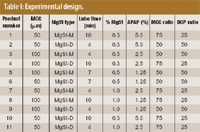
Table I: Experimental design.
Experiment designs. APAP was used at concentrations of 1.25, 2.5, and 5.0% w/w. MgSt was used at concentrations of 0.3, 0.5, and 1.0% w/w. The experimental design was a modified Plackett–Burman fractional factorial having two levels with two center points. Eleven batches, each at 10-kg batch size, were blended in a 1-ft3 twin-shell blender (Patterson-Kelley, Stroudsburg, PA). This fractionalization allowed for a reduction of input variables or factors with the benefit of identifying the key factor variables that affected product quality. The design also enabled the evaluation of main effects aliased with two-way interactions (17). Tables I and II show the designs and independent variables (factors). Results from the experimental design provided information for optimization of the study (see Table I). Subsequently, six optimization batches were processed to substantiate the preliminary findings from the 11-batch runs (see Table II). The dependent variables (responses) included ejection force and total compression force (precompression and main compression forces).

Table II: Optimized design.
Prelubrication blend uniformity was predicted using multiple effusivity sensors fitted to the blender as previously described (2, 12). Prelubrication and postlubrication blend uniformity samples were collected using a sampling thief (Globe Pharma, New Brunswick, NJ) for comparative analysis. Blend samples were analyzed for the APAP assay with an internally validated high-performance liquid chromatography (HPLC) method.
The blends were compressed using a 10-station instrumented tablet press (Natoli Engineering, St Louis, MO) with 0.4375-in. standard round, concave tooling. All tablets were compressed to target hardness of 8.0 kp using a hardness tester (Pharmatest, Piscataway, NJ), and target weight of 500 mg was measured using a bench scale (Sartorius, New York, NY). Tablet press speed was maintained at 17 rpm. Tablet friability limit was set at not more than (NMT) 0.8% using a friability tester (Pharmatest). Lubrication performance and influence on the tablets' physical attributes were evaluated on the basis of the main compression force, precompression force, ejection force, and tablet knock-off using a real-time data acquisition tool (Natoli Engineering, St. Louis, MO). In vitro dissolution studies were conducted according to USP Method, and a similarity factor, f2, was derived for comparative analysis. Data analysis was conducted using a statistical tool ("Minitab," Minitab Inc., State College, PA).
Solid-state characterization of MgSt hydrates. Solid-state characterization of MgSt hydrates was conducted at particle level using a particle-size analyzer, and at molecular level using DSC, powder X-ray diffraction (PXRD), and scanning electron microscopy (SEM).
Powder X-ray diffraction. PXRD patterns of samples were measured with a Siemens D500 X-ray diffractometer over the range of 2q = 2° to 40° and a 0.02° step size.
Scanning electron microscope. The morphologies of the samples were investigated using a scanning electron microscope (model S-4500, Hitachi, Japan). A Cressington 108 Auto/SE sputter coater was used (Cressington Scientific, Watford, UK). Images were captured with the secondary electron detector. A small portion of the powdered sample was distributed onto a conductive carbon adhesive disk on SEM stubs for SEM imaging. The specimens were sputter coated with gold–palladium to impart conductivity. The instrumental parameters were: electron beam source = W filament; accelerating voltages = 15 kV; objective aperture = 50 μm (aperture #3); vacuum mode = high vacuum; imaging detector(s): SE; magnification = 1000×, 2500×, and 3500×; specimen tilt = 0.0°; and working distance = nominal 16.
Particle-size distribution and percent water. Particle-size distributions were determined using a laser diffraction system (series 2600, Malvern Instruments Ltd., Malvern, UK) equipped with a 63-mm lens (size range of 1.2–118 μm) and a stirred cell.
Differential scanning calorimetry. Differential scanning calorimetry (Q100 DSC, TA Instruments, New Castle, DE) was done between temperatures from –60 to +190 °C at a heating rate of 2 °C/min and a nitrogen purge of 50 mL/min. Samples (3–5 mg) were tested in crimped-aluminum pans, and an empty pan was used as a reference. The temperature axis and cell constant of DSC were previously calibrated with pure standard of indium. Data acquisition and analysis were conducted using TA Instruments software.
Thermal gravimetric analysis. Thermal gravimetric analysis (Q50 TGA, TA Instruments) was carried out from 25 to 190 °C at a heating rate of 5 °C/min. Data acquisition and analysis were conducted using TA Instruments software.
Near infrared spectroscopy. NIR spectral analysis (NIR analyzer, Thermo Fisher Scientific, Waltham, MA) was conducted using standard mixtures having known composition of MgSt monohydrate and dihydrate prepared from 92.0% MgSt-M and 95.4% MgSt-D stock material.
Blend homogeneity. Effusivity sensor suitability with baseline run was conducted using neat microcrystalline cellulose, NF to enable the effusivity sensors to predict homogeneity via in-line and real-time measurement. The placebo material was blended for a specified duration, and the synchronization pulse with baseline was established for the effusivity sensors.
The prelubrication homogeneity of the blends was determined on the basis of real-time analysis conducted with Effusivity Sensor Package software (ESP, Mathis Instruments, Fredericton, Canada). The system synchronization enabled the sensors to dynamically obtain a real-time data stream from the rotating blender (see Figure 4). Effusivity sensors monitor the blending of powder particles on the basis of the heat-transfer properties of the composite powder mixture. An explanation for this sensitivity to material blending or mixing is related to the ability of these powder particles or ingredients to mix in various proportions as they attend homogeneity. This is analogous to a move from "divergence" toward "convergence" or uniformity. The selection of any empirical uniformity value may depend on several factors, including the nature of materials, type of process, and individual effusivity values of the ingredients. Several works have shown that low relative standard deviation (RSD) in a blending process signifies uniformity in mixing or blending (6, 12, 18, 19). End-point prediction with effusivity was based on the combination of stable average effusivity and a decaying RSD.
Blend samples were collected using a sample thief from each batch at the end of prelubrication and postlubrication blending. Blend samples of about two times the unit-dose (500 mg × 2 = 1000 mg) were tested based on an internally validated HPLC method for APAP. The mobile phase was a mixture of methanol and water with a flow rate of 1.0 mL/min and detection at 280 nm.
Tablets' physical attributes and content uniformity. Compression of the batches was conducted using a 10-station instrumented press (Natoli Engineering). Compression parameters were monitored based on constant (target) tablet weight (500 mg) and hardness (8 kp). Based on the fact that MgSt type, percentage of MgSt, and lubrication time differed in the batches, the effects of these variables on precompression force, main compression force, ejection force, knock-off force, and tablet friability were monitored or measured to evaluate the level of such influence. Additional influence was also expected from the differing percentage of APAP and diluents. An attempt was made to statistically analyze such influence to understand the main effects and interactions.
Using a stratified sampling method, tablets were collected at intervals during the compression runs (20). Content uniformity was conducted using an internally validated HPLC method for APAP. Mean assay and %RSD for 10 tablets were determined.
In vitro dissolution. In vitro dissolution studies were performed using an USP Type 2 dissolution apparatus at 50 rpm. The dissolution media consisted of 900 mL degassed purified water, USP, maintained at 37 °C ± 0.5 °C. A 5-mL aliquot was withdrawn at intervals of 5, 10, 15, and 30 min. Drug content was determined by HPLC at 280 nm. All dissolution tests were conducted in triplicate. The similarity was determined by the model independent approach using a similarity factor (f2) as described in the FDA Guidance for Industry: Dissolution Testing of Immediate Release Solid Oral Dosage Forms (21). The similarity factor (f2) is defined as follows:

in which Rt and Tt are the average percentage of drug dissolved at each sampling time for reference (R) and the test (T) preparations, respectively, and n is the number of samples. An f2 value between 50 and 100 suggests that the two dissolution profiles are similar.
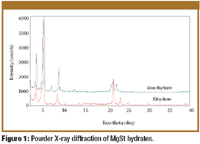
Figure 1
Results and discussion
Solid-state characterization of MgSt hydrates. Isolation of the dihydrate and monohydrate forms by using the vegetable source of MgSt was successfully conducted by the Mallinckrodt team (10). The results of the solid-state characterization showed that on the basis of particle and molecular characterization, substantive evidence exists to support differences in the nature and behavior of the two hydrates (11). Lubrication efficacy of MgSt, vegetable or animal source, has been widely associated with its physicochemical properties such as crystalline state, crystal shape, particle size, particle-size distribution, and particle morphology with a given fatty acid composition consisting of stearic and palmitic acids and fatty acid ratio (9).
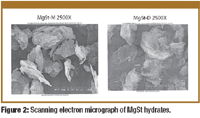
Figure 2
Powder X-ray diffraction. Figure 1 shows the results of the powder X-ray diffraction conducted on the MgSt hydrates.

Table III: MgSt pseudopolymorph particle size and percent water.
Scanning electron microscope. Figure 2 shows the results of the characterization conducted on the MgSt hydrates using scanning electron microscopy at a magnification of 2500×.

Figure 3
Particle size, percent water, and concentration of neat MgSt-M and MgSt-D. Results of particle size and free and bound-moisture analysis for the MgSt hydrates are shown in Table III. The neat dihydrate had a concentration of 95.4%, and the neat monohydrate had a concentration of 92.0%. The results also indicate that the nominal mean particle size of the monohydrate is 10.6 μm, and the dihydrate has a nominal mean particle size of 14.3 μm. In addition, percent bound moisture was 2.8% for MgSt-M and 5.6% for MgSt-D. Although the percent of free water was generally low, MgSt-M had 0.6%, and little or no free water was found in MgSt-D.

Figure 4
Differential scanning calorimetry, thermogravimetry, and NIR spectroscopy. The profiles depicted in Figures 3a–c show the results of the DSC, thermogravimetry, and NIR reflectance for the MgSt hydrates. These profiles depict the differences between the hydrates of MgSt. The NIR spectra were provided by Kaufman (11).
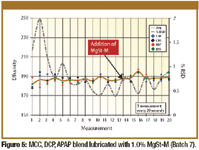
Figure 5
Predicted blend homogeneity and assay. The profile of the baseline run with neat MCC is depicted in Figure 4. Results show an average effusivity for the placebo material of 171 Ws0.5 /m2 K (n = 20), with RSD = 0.7%. Figures 5 (Batch 7) and 6 (Batch 11) show the effusivity profiles for ternary blends of MCC, DCP (75:25), and 2.5% w/w APAP lubricated with 1.0% w/w MgSt-M and MgSt-D, respectively. Figures 7 (Batch 12) and 8 (Batch 14) show the effusivity profiles for ternary blends of MCC, LAC (75:25), and 1.25% w/w APAP lubricated with 1.0% w/w MgSt-M and MgSt-D, respectively. Table IV shows the results of the physical and chemical testing for the blends. Blend results indicate that the prelubrication end-points as predicted by effusivity sensors gave good correlation to the blend assay from HPLC analysis. Blend uniformity results for Batch 12, after 4 min of lubrication with MgSt-M, however, show a mean blend uniformity assay of 109.0%, with a failing RSD of 23.5%. Conversely, Batch 14 lubricated with MgSt-D shows an acceptable mean blend uniformity assay of 94.8% with an RSD of 1.6%.
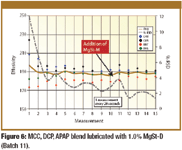
Figure 6
The influence of lubrication and MgSt type on blend integrity. The influence of MgSt type and concentration on effusivity was analyzed using one-way analysis of variance (ANOVA). Analysis of the change (delta) in average effusivity between prelubrication and postlubrication blends containing MgSt-M and MgSt-D, using Tukey's paired comparison at 95% confidence limit, shows statistical significance of p <0.05 (see Table V). The pairwise comparison is indicative of the differing influence attributable to the distinct hydrate forms of the lubricant. In addition, a plot of main effects using the data means from the responses shows that the delta on average effusivity was greater for MgSt-M than for MgSt-D (see Figure 9).
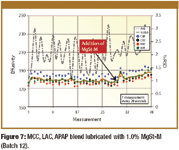
Figure 7
Results from the blending studies, as profiled by the in-line effusivity sensors, also show that when ternary systems containing MCC–DCP and MCC–LAC as diluents were lubricated with MgSt-M and MgSt-D, the delta effusivity values were higher for the blends containing MgSt-M. (Compare Batch 7 and Batch 12 versus Batch 11 and Batch 14 in Table V). These results indicate the ternary systems containing MgSt-D show less degree of densification for both MCC–LAC and MCC–DCP diluent systems before and after lubrication.
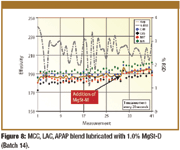
Figure 8
Similarly, with the same 75:25 diluent ratio, MCC–DCP blends lubricated with MgSt-M exhibited 2–3 times more densification than MgSt-D (Batch 7 versus Batch 11). Also MCC–LAC blends with a 75:25 ratio, when lubricated with MgSt-M, showed about 1.6 times more densification than blends with MgSt-D (Batch12 versus Batch 14). Moreover, within the MCC–LAC diluent system, the 50:50 diluent ratio tends to show higher delta effusivity than the 75:25 ratio. (Batch 12 versus Batch 16, and Batch 14 versus Batch 17). This result could be attributed to the increasing contribution of lactose in the formulation, particle–particle interaction, and diluent-type sensitivity to the influence of MgSt. Although the mechanism of the densification may not be fully understood, it is believed that the finer particles of the lubricant tend to displace the air pockets between larger particles and occupy the interstices with a resultant more densely packed powder mixture. Such particulate packing, presumably a result of MgSt addition, could disturb the established blend uniformity.

Table IV: Physical and chemical results for blends. Blend uniformity and effusivity results.
Content uniformity. The data in Table VI show the compression batches containing MCC–DCP and MCC–LAC binary diluents systems. Results show that except for Batch 8, all batches gave acceptable results for content uniformity. The mean assay for 10 tablets for Batch 8 was 96.9%. The %RSD was 7.9, however, which is much higher than the acceptable limit (20). Batch 8 was lubricated with 1.0% of MgSt-M for 10 min. This result implies that an extended period of lubrication could affect the tablets' content uniformity. In their study, El Hagrasy, Chang, and Kiang alluded to the risk of lubricant mixing when they monitored the lubrication of placebo granules with various levels of MgSt (22). Their findings suggested that improper mixing of lubricant in the final blends could compromise tablet dissolution and quality.
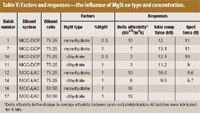
Table V: Factors and responses-the influence of MgSt on type and concentration.
Based on a Plackett–Burman design, % MgSt, MCC–DCP ratio, Avicel type, % APAP, and lubrication time were evaluated for their influence on ejection force and total compression force. Using the method of least squares, regression models were developed for the total force (precompression and main compression forces) and the ejection force to elucidate the influence of the lubricants on the compression process.

Figure 9
Table VII shows the regression analysis for the ejection force. Based on the tablet physical results, the diluent ratio had the greatest influence on ejection force (p <0.005). The data also showed that the % API and % MgSt in the formulation had second- and third-highest influence on tablet ejection based on the coefficient at p <0.005 Overall, R2 (indicating the linearity of the regression) was 0.9250, suggesting that the selected model design was appropriate.

Table VI: Physical and chemical results for tablets.
In addition, the regression model for the total forces (precompression and main-compression forces) as depicted in Table VIII shows that the diluent ratio also had the highest influence on combined compression forces (p <0.005). The second and third highest–ranking responses, based on the coefficient at p <0.005, were the percentage of MgSt and the type of MCC, respectively. The model shows a linearity, R2= 0.9110. These regression models show that the influence of the diluent ratio, percentage of MgSt, percentage of API, and type of MCC, if held constant, could offer some insights into the subtle characteristics of other factors such as the type of MgSt and the duration of lubrication. As such, an optimized design was constructed to keep these factors the same and minimize their influence to fully elucidate the presence (or absence) of influence of differing MgSt hydrates.

Table VII: Regression analysis for ejection force.
Influence of MgSt type and duration of lubrication on blend uniformity assay. Two experiments were conducted using a binary diluent system of MCC (Avicel PH 101) and LAC at the ratio of 75:25, with APAP as the active ingredient at 1.25% w/w concentration. With the level of MgSt at 1.0% w/w, the influence of lubrication on blend uniformity assay was monitored at 2-, 4-, 8-, 12-, and 16-min time points. Results show that Batch 13 lubricated with MgSt-M gave failing %RSD on blend uniformity assay at 2-min (36.0%) and 4-min (8.1%) time points (see Table IX). Results at the 8-, 12-, and 16-min time points, however, were acceptable. For Batch 15 lubricated with MgSt-D, the results at all the time points were acceptable. Although no reason was found for the failed results for Batch 13, the influence of the MgSt type on a uniformity blend could not be ruled out.

Table VIII: Regression analysis for total force (precompression and main).
Influence of type and concentration of MgSt hydrate on tablet compression. The tablet characteristics shown in Table VI depict some distinct effect in the total compression forces, ejection force, and tablet knock-off between the blends lubricated with different pseudopolymorphic forms of MgSt. These differences in tableting forces appear to be evident under similar formulations and with preset target ranges for tablet weight and hardness. So long as the preblend components of the formula are comparable, the anticipated variables would include percentage of MgSt and duration of lubrication. These two variables tend to influence the compressibility, tablet ejection, and knock-off. The efficiency of a lubricant during a tableting operation hinges on its ability to facilitate tablet release postcompression. The amount of such lubricants, however, combined with the duration of lubrication, often influence the forces acting on the upper and lower punches. The results indicate that the average total compression forces and ejection force was lower for MgSt-D than the MgSt-M (see Table VI and Figures 10 and 11).

Table IX: Postlubrication of MCCâLAC binary diluent systems with different MgSt types.
The varying effects of MgSt on formulations with various types of diluents were previously observed by Swaminathan, Simmons, and Bourland (23). They concluded that MgSt when used as an intragranular agent in a roller compaction process had greater effect on tablet tensile strength of viscoelastic formulations (such as LAC) than on intermediate or brittle formulations (such as DCP). Although the role of MgSt as an extragranular agent is well understood, the results from compression process of the current study indicate that regardless of the MgSt type, formulations that contained an MCC–LAC diluent system required lower compression and ejection forces than those that contained an MCC–DCP diluent system to produce tablets with desired quality attributes (see Table VI). More important, and on the basis of tablet characteristics, blends lubricated with the MgSt-D appear to require lower compression and ejection forces to produce comparable tablets as those containing MgSt-M. With respect to the lubricated blends, the profiles show that less densification occurs when the dihydrate was used than when the monohydrate form was used. Such disturbance in blend homogeneity as a result of the introduction of lubricants such as MgSt, if not monitored and controlled, could portend blend or product failure.
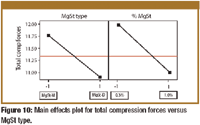
Figure 10
In vitro dissolution: binary diluent systems. In vitro dissolution was conducted on six tablets from each of batches 1, 7, 10, 11, 12, and 14. These batches were lubricated with different amounts of MgSt-M and MgSt-D ranging from 0.3% to 1.0%. Figure 12 shows results from Batch 1 and Batch 10 lubricated for 10 min with 0.3% MgSt-M and MgSt-D, respectively. Figure 13 shows results of Batch 7 and Batch 11 lubricated for 4 min with 1.0% MgSt-M and MgSt-D, respectively. And Figure 14 shows results from Batch 12 and Batch 14 lubricated for 4 min with 1.0% MgSt-M and MgSt-D, respectively. Results of the in vitro dissolution suggest that all batches met the criteria for similarity (f2 between 50 and 100) as stipulated in the FDA guidance (see Figures 12–14 and Table X). These results indicate that finished products containing the dihydrate polymorph could provide comparable quality to those containing the monohydrate form.
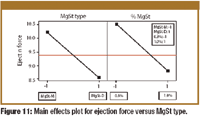
Figure 11
Conclusion
Magnesium stearate is currently available commercially as the monohydrate form or a mixture of monohydrate with a trace of amorphous and other hydrate forms made from both animal and vegetable fatty acid sources. The isolation of pure magnesium dihydrate form has provided a neat dihydrate form with distinct physicochemical properties from the monohydrate form (10).

Figure 12
Physicochemical analysis conducted with scanning electron microscopy, powder X-ray diffraction, near-infrared spectroscopy, differential scanning calorimetry, particle-size analysis, and thermogravimetry suggest discernable differences between MgSt monohydrate and dihydrate.
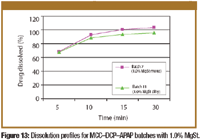
Figure 13
The lubrication of direct-compressible blends with the hydrates of MgSt has presented evidence of differences in the effects these hydrates could have on blend homogeneity and tablet compression. In-line effusivity sensors predicted blend uniformity in all prelubrication blends down to 1.25% w/w of active pharmaceutical ingredient in the formulations. In addition, the in-line effusivity sensors suggested that lubricating blends with the monohydrate form could cause greater disturbance in blend particlearrangement and densification than the dihydrate form under similar process conditions.

Figure 14
Finally, compression results showed that blends lubricated with MgSt-M required higher total-compression forces, ejection force, and knock-off force than those with MgSt-D. Similarity comparison based on the f2 factor, as conducted on finished products, indicates that the blends lubricated with MgSt-D compared well with those containing MgSt-M.
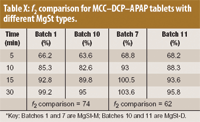
Table X: f2 comparison for MCCâDCPâAPAP tablets with different MgSt types.
Acknowledgment
The authors express gratitude to Dr. Nancy Mathis and Michael Emanuel of Mathis Instruments, Doug Kirsch and Dale Natoli of Natoli Engineering Co., Mike Kelly, Dr. Gary Nichols, Samantha Compton, Dan Ramlose, and Don Krieger of Mallinckrodt, and Dr. John Kaufman of the US Food and Drug Administration in St. Louis for their valuable discussion and contributions to this work.
Patrick Okoye is a quality manager at OSG/Kolmar Laboratories, Port Jervis, NY. Stephen H. Wu, PhD,* is a technical fellow in the Pharmaceutical R&D division of Mallinckrodt Pharmaceutical–Covidien Ltd., 385 Marshall Ave. Webster Groves, MO 63119, tel. 314.654.0281, Stephen.Wu@Covidien.com
*To whom all correspondence should be addressed.
Submitted Feb. 13, 2007. Accepted:Mar. 14, 2007.
References
1. M. Turkoglu, I. Sahin, and T. San, "Evaluation of Hexagonal Boron Nitride as a New Tablet Lubricant," J. Pharm. Dev. Technol. 10 (3), 381–388 (2005).
2. P. Okoye et al., "Thermal Effusivity Blend Lubrication Data as a PAT Platform to Optimize Tablet Compression Performance," AAPS Poster #T3195 (2005).
3. H. Lieberman, L. Lachman, and J. Schwartz, Pharmaceutical Dosage Forms: Tablets Vol. 1 (Marcel Dekker, New York, 2d ed., 1989), pp. 195–246.
4. P. Arratia et al., "Characterizing Mixing and Lubrication in the Bohle Bin Blender," Powder Technol. 161 , 202–208 (2006).
5. A. Stallings, "Approach to Understanding Immediate Release Dosage Form Dissolution Failures due to Effects of Magnesium Stearate in Pharmaceutical Formulations," AAPS poster W4332 (2005).
6. A. Alexander et al., "Characterization of the Performance of Bin Blenders: Part 3 of 3—Cohesive Powders," Pharm. Technol. 28 (9), 54–74 (2004).
7. D. Wurster, S. Likitlersuang, and Y. Chen, "The Influence of Magnesium Stearate on the Hiestand Tableting Indices and Other Related Mechanical Properties of Maltodextrins," J. Pharm. Dev. Technol. 10 (4), 461–466 (2005).
8. V. Swaminathan and D. Kildsig, "An Examination of the Moisture Sorption Characteristics of Commercial Magnesium Stearate," AAPS PharmSciTech 2 (4), article 28 (2001).
9. K. Rao et al., "Impact of Solid-State Properties on Lubrication Efficacy of Magnesium Stearate," J. Pharm. Dev. Technol. 10 (3), 423–437 (2005).
10. S. Wu, Effects of Magnesium Stearate Hydrates on Powder Flowability, Tablet Ease, and Tablet Quality, Technical Report (Tyco Healthcare–Mallinkrodt, 2006).
11. J. Kaufman et al., "Multivariate Calibration of Mixtures of Magnesium Stearate Hydrates," AAPS abstract T3288, 2006.
12. P. Okoye et al., "Understanding Scale-Up and Process Equipment Change: Case Study using Thermal Effusivity Sensor as a PAT Tool," ISPE News Magazine 3 (3), 4–8 (2006).
13. M. Emanuel and P. Okoye, "Evaluation of a Simple Fluid-bed Dryer Sampler Modification for On-line Profiling and End-Point Determination Utilizing Effusivity," AAPS abstract T3308 (2006).
14. G. Fariss, R. Kientz, and P. Okoye, "Thermal Effusivity and Power Consumption as PAT Tools for Monitoring Granulation End-Point, Pharm. Technol. 30 (6), 60–72 (2006).
15. B. Ennis and M. Emanuel, "Comparison of Shear Cell and Effusivity Methods to Determine Flow Properties of Common Excipients and Blends," AAPS abstract W5219 (2006).
16. P. Sheskey, R. Rowe, and P. Weller, Handbook of Pharmaceutical Excipients, (Pharmaceutical Press, London, 4th ed., 2003).
17. Minitab: Data Analysis and Quality Tools (Minitab Inc., State College, PA), 2000.
18. N. Mathis, "Monitoring Blend Uniformity with Effusivity," Pharm. Technol. 26 (4), 80–84 (2002).
19. R. Hwang, Y. Huang, and G. Peck, "Evaluation of Blend Sampling Errors: A Statistical Approach," Pharm. Technol. 23 (6), 56–65 (1999).
20. FDA. Generic Drug Draft: Blend Uniformity Analysis (FDA, Rockville, MD), www.fda.gov/cder/guidance, 05/17/2002, accessed Aug. 10, 2007.
21. FDA, Guidance for Industry: Dissolution Testing for Immediate Release Solid Oral Dosage Forms, (FDA, Rockville, MD), www.fda.gov/cder/guidance, 1997, accessed Aug. 10, 2007.
22. A. El Hagrasy, S. Chang, and T. Hu, "Evaluation of Risk and Benefit in the Implementation of Near-Infrared Spectroscopy for Monitoring of Lubricant Mixing," J. Pharm. Dev. Technol. 11 (3), 303–312 (2006).
23. V. Swaminathan, D. Simmons, and M. Bourland, "Effect of Magnesium Stearate on Ribbon, Granule and Tablet Characteristics in Dry Granulation," AAPS abstract T2212 (2006).
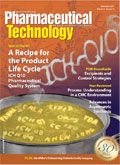
Drug Solutions Podcast: A Closer Look at mRNA in Oncology and Vaccines
April 30th 2024In this episode fo the Drug Solutions Podcast, etherna’s vice-president of Technology and Innovation, Stefaan De Koker, discusses the merits and challenges of using mRNA as the foundation for therapeutics in oncology as well as for vaccines.